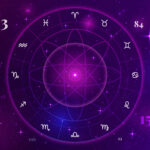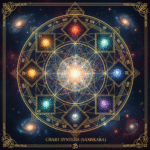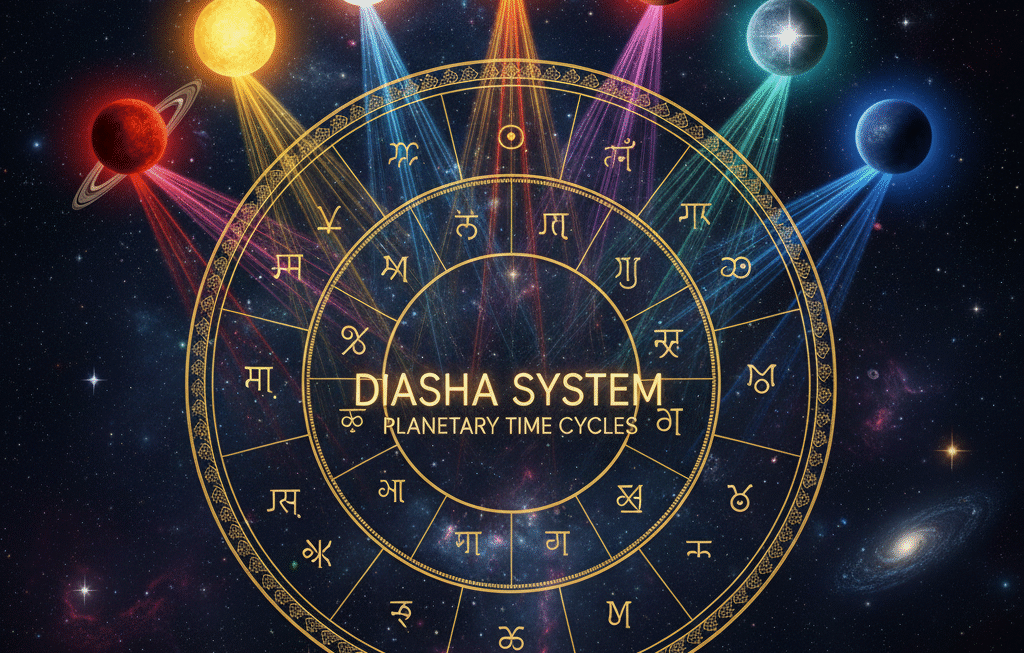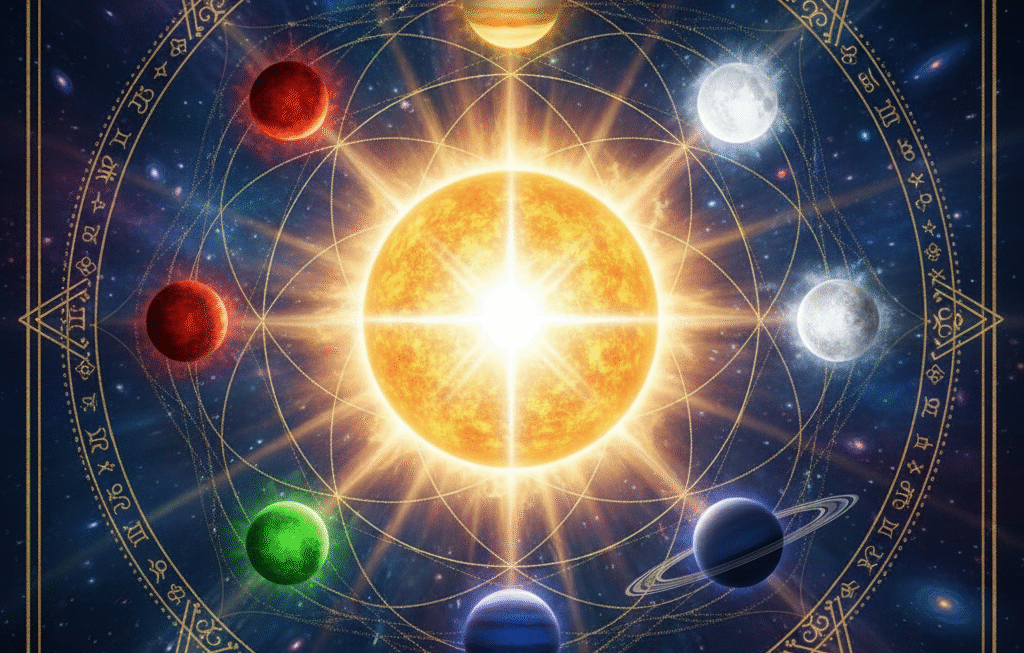In dispositor Vedic astrology, each planet’s power is linked through a rulership chain, revealing deeper connections and hidden influences in a chart.
Understanding the dispositor (sign lord) reveals who influences whom in your chart. It’s like discovering the chain of command in a cosmic organization — the hidden thread connecting all planetary energies.
In this guide, you’ll learn what a dispositor is, how to trace the planetary dispositor chain, and how it shapes your entire horoscope.
What Is a Dispositor in Vedic Astrology?
(Keywords: dispositor vedic astrology, what is dispositor)
Opinion: A Dispositor is the planet that rules the sign where another planet is placed.
Reason: Since each zodiac sign has a planetary ruler, any planet occupying that sign comes under the influence of its ruler. Thus, the ruler becomes the dispositor — the host who colors the guest planet’s expression.
Example:
If Mars is in Taurus, its dispositor is Venus, because Venus rules Taurus. So Mars (action, courage) acts through the lens of Venus (beauty, harmony).
Restatement: Therefore, to understand any planet’s true behavior, you must examine its dispositor, for it reveals the environment through which the planet expresses itself.
The Logic Behind the Dispositor System
Think of the planets as actors and the zodiac signs as stages. Each stage belongs to a specific director — the sign lord.
When an actor performs on that stage, the director decides the tone, direction, and mood of the performance. Similarly, the sign lord (dispositor) determines how effectively the planet can express its nature.
In other words:
The dispositor shows the source of power and control behind a planet’s actions.

The Dispositor Chain: The Cosmic Flow of Influence
(Keywords: planetary dispositor chain, ruling planet chain)
Here’s where it gets fascinating — every planet’s dispositor may itself be placed in another sign, ruled by yet another planet. This creates a dispositor chain, showing the flow of energy and influence through your chart.
Let’s look at an example:
Example Chart:
- Sun in Scorpio → dispositor = Mars (rules Scorpio)
- Mars in Taurus → dispositor = Venus (rules Taurus)
- Venus in Libra → dispositor = Venus itself
Here, Venus is the final dispositor because the chain stops with Venus ruling its own sign.
So, this person’s actions (Mars) and authority (Sun) are ultimately guided by Venusian themes — beauty, diplomacy, creativity.
Types of Dispositors
To analyze effectively, astrologers recognize different kinds of dispositors:
1. Simple Dispositor (Sign Lord)
The basic concept — the planet that owns the sign where another planet sits.
Example: Mercury in Aries → Mars is the dispositor.
2. Mutual Dispositors (Exchange Lords)
When two planets occupy each other’s signs, they become Mutual Dispositors (Parivartana Yoga).
Example:
- Sun in Libra (Venus’s sign)
- Venus in Leo (Sun’s sign)
They exchange energy, forming a direct, powerful loop of influence.
Effect:
This mutual exchange strengthens both planets and links their houses closely.
3. Final Dispositor
If, while tracing the dispositor chain, you reach a planet that is in its own sign, that planet becomes the Final Dispositor — the anchor point of your chart’s energy.
Example:
If Mercury → Mars → Venus → Venus (in Libra), then Venus is the final dispositor.
Such a planet becomes a core influence in your chart, showing where your life energy ultimately gravitates.
4. Multiple Dispositor Systems
In some charts, no single final dispositor exists. Instead, there are multiple chains, each ending in a different self-ruled planet.
For instance:
- Sun → Mars → Venus → Venus
- Jupiter → Saturn → Saturn
This means the person’s life has two core influences — one Venusian (relationships, creativity) and one Saturnine (discipline, karma).
Why Dispositors Matter in Chart Analysis
Opinion: The dispositor reveals the true strength and expression of a planet.
Reason: A planet’s dignity (exalted, debilitated, or neutral) is important, but its dispositor decides how that dignity manifests in real life.
Example:
- Jupiter exalted in Cancer → Dispositor is Moon.
- If the Moon is strong, Jupiter’s wisdom flows beautifully.
- If the Moon is weak or afflicted, Jupiter’s exaltation loses stability.
- If the Moon is strong, Jupiter’s wisdom flows beautifully.
Restatement: The dispositor acts like the foundation of a planet’s results — if the foundation is weak, even a strong planet can stumble.
The Dispositor’s Role in Yogas and Strength
When interpreting any yoga (planetary combination), always check the dispositor of the planets forming that yoga.
For example:
- Raja Yoga: Formed by lords of Kendra and Trikona houses.
- The dispositor of these lords determines whether the yoga will manifest fully or remain dormant.
- The dispositor of these lords determines whether the yoga will manifest fully or remain dormant.
- Dhana Yoga (Wealth Yoga): If the dispositors of 2nd and 11th lords are strong, wealth flows steadily.
- Karma Bhava (10th House): The dispositor of the 10th lord reveals the real environment of your career and authority.
Step-by-Step: How to Trace the Dispositor Chain in Your Chart
Let’s make it practical:
- Open your birth chart (Kundli).
Note the sign in which each planet is placed. - Find the Sign Lord of that sign.
Use this list:
- Aries, Scorpio → Mars
- Taurus, Libra → Venus
- Gemini, Virgo → Mercury
- Cancer → Moon
- Leo → Sun
- Sagittarius, Pisces → Jupiter
- Capricorn, Aquarius → Saturn
- Aries, Scorpio → Mars
- Locate that Sign Lord in your chart.
See which sign it occupies. - Repeat the process until you reach a planet in its own sign.
That’s your Final Dispositor. - Analyze the chain.
- What planets are involved?
- Which houses are connected?
- Which planet is the final ruler?
- What planets are involved?
This chain shows the hierarchy of influence — who reports to whom in your cosmic chart.
Illustrative Example
Let’s take an example:
- Mercury in Sagittarius → dispositor = Jupiter
- Jupiter in Capricorn → dispositor = Saturn
- Saturn in Libra → dispositor = Venus
- Venus in Taurus → dispositor = Venus (own sign)
So the chain is:
Mercury → Jupiter → Saturn → Venus
The final dispositor is Venus — meaning all these planets ultimately express through Venusian energy.
The person’s intellect (Mercury), wisdom (Jupiter), and discipline (Saturn) all serve the values of beauty, harmony, and relationships (Venus).
Psychological and Spiritual Interpretation
On a deeper level, the dispositor chain represents your inner command structure — how your different aspects coordinate.
- If the chain ends with Saturn, you’re karmically driven, practical, and duty-oriented.
- If it ends with Jupiter, you’re guided by faith and wisdom.
- If it ends with Venus, love, aesthetics, and balance govern your expression.
- If it ends with Sun, you’re driven by ego, identity, and purpose.
Spiritually, the final dispositor points to your core frequency — the planet whose vibration defines your soul’s operating mode in this lifetime.
Common Misunderstandings About Dispositors
Myth 1: “A planet acts independently.”
Truth: Every planet depends on its dispositor for full expression.
Myth 2: “Only strong planets matter.”
Truth: Even a debilitated planet can act powerfully if its dispositor is strong.
Myth 3: “The dispositor is secondary.”
Truth: The dispositor often determines whether a planet’s promised results will actually materialize.
Final Thoughts: The Hidden Web of Rulership
When you follow the chain of dispositors, you uncover the hidden architecture of your chart — the way energies flow, link, and report back to a central command.
This system transforms astrology from a static diagram into a living organism, where each planet plays its part under higher guidance.
Your final dispositor is like your chart’s CEO — the ultimate authority shaping your motivations, destiny, and life path.
So the next time you study your Kundli, don’t just stop at where planets sit — follow the chain, and find out who’s really in charge.











